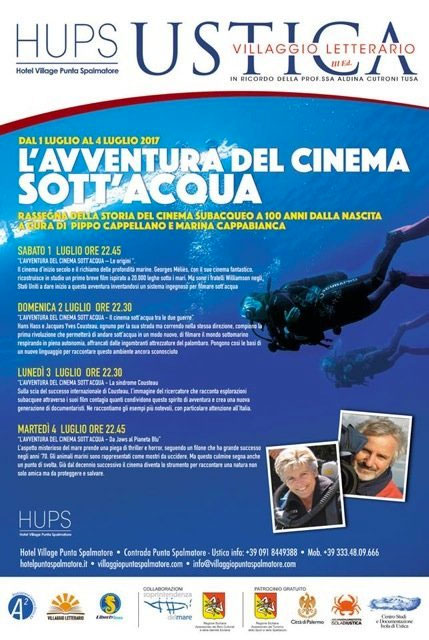THE ADVENTURE OF CINEMA UNDER WATER
Ustica, 1-4 July 2017
by
Pippo Cappellano and Marina Cappabianca
4 evenings with film screenings, photographic images and many surprising anecdotes to tell 100 years of underwater cinema.
It was 1916 when the first feature-length film inspired by the adventures of Jules Verne was released in the United States 20,000 leagues under the sea. For the first time viewers could "see" on a movie screen, which already had something magical in it, the wonders of the Bahamas and the richness of their lives, but - true to the original book - the film also represented terrible monsters marines that the protagonists faced with incomparable courage.
Seeing those first images today - and many of those that followed in the immediately following decades - makes us smile, but the story of this great adventure is extraordinary and unique and it is thanks to those first brave experimenters, who have inspired whole generations, if we have learned not only to know the sea but also to respect it.
The origins. Early 20th century cinema and the call of the sea depths. Georges Méliès, with his fantastic cinema, reconstructs in the studio a first short film inspired by 20,000 leagues under the sea. But it is the Williamson brothers in the United States who begin this adventure by inventing an ingenious system for filming underwater.
Between the two wars. Hans Hass and Jacques Yves Cousteau, each on his own way but running in the same direction, make the first revolution that will allow them to go underwater in a new way, to film the underwater world breathing in full autonomy, freed from the cumbersome equipment of the diver . In this way they lay the foundations for a new language to describe this still unknown environment.
The Cousteau syndrome. In the wake of Cousteau's international success, the image of the researcher who tells underwater explorations through his films infects those who share this spirit of adventure and creates a new generation of documentarians. We tell the most remarkable examples, with particular attention to Italy.
From Jaws to the Blue Planet. The mysterious aspect of the sea takes a turn of thriller and horror, following a trend that has great success in the 70s. Marine animals are represented as monsters to kill. But this climax also marks a turning point.
As early as the following decade, cinema became the tool to tell a nature that was not only friendly but to be protected and saved.
Pippo Cappellano
Journalist, director and author of documentaries, he began his activity in the late 60s. He has directed and produced several successful RAI series on marine exploration and underwater archeology. He has directed over 300 documentaries in various parts of the world on themes of nature, science and history. For his dissemination activities he received the "Tridente d'Oro" in 1983 and since 2013 he has been Deputy Vice President of the International Academy of Underwater Sciences and Techniques.
Marina Cappabianca
Producer, author and director of documentaries in particular in the field of nature and history. He has coordinated international co-productions with television partners such as Discovery, National Geographic, WGBH Nova, WDR and ZDF in Germany, BBC, France 2, France 3, France 5.
He has published several articles on topics related to the activity of the documentary.

 English (UK)
English (UK)  Italiano
Italiano  Français (France)
Français (France) 






